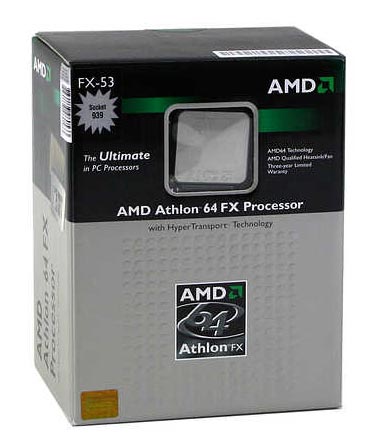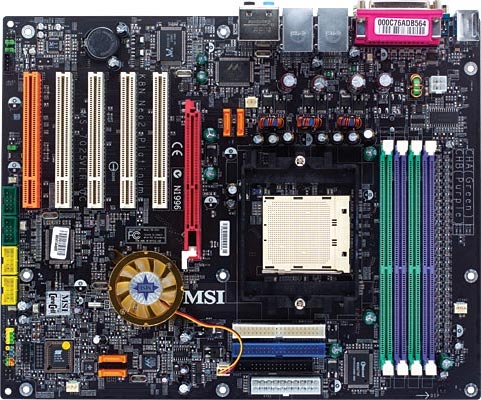Overclocking Buyer's Guide - September 2004
by Wesley Fink on September 17, 2004 12:05 AM EST- Posted in
- Guides
CPU and Motherboard: PERFORMANCE OC Recommendations
CPU: AMD Athlon 64 FX53 (2.4GHz 1024K L2 cache)Motherboard: MSI K8N Neo2 (nForce3 Ultra)
Price: CPU - $850 shipped (Retail). Motherboard - $139 shipped

For Overclockers looking for the best performance possible, it would be tough to recommend anything other than the Athlon 64 FX53. The Athlon 64 is currently the fastest processor that you can buy; the Dual-Channel Socket 939 is the top-performing A64 Socket, and the FX is the fastest 939 processor. The FX also has the distinction of being the only processors that are completely unlocked. That means that you can adjust multipliers both up and down, to obtain the highest possible speed at the fastest DDR400 memory timings, or to obtain the highest FSB that your high speed memory can run or your CPU can reach. Most FX53 that we have tested easily reach 2.6GHz at default voltage with air cooling, and some do even better. This pegs performance at a clock speed that we won't see in a retail CPU until late this year.
While the 3500+ (2.2GHz) can reach similar speeds, it is still multiplier locked at the top (lower multipliers can be selected, though) and the cache is only half of what is found on FX53. The 3800+ runs at the same 2.4GHz with half the cache, but again, the regular Athlon 64 are top-locked, and the small price difference between FX53 and 3800+ makes it difficult to choose the 3800+ over the FX53. What you get in the FX53 is the fastest stock performance currently available among desktop processors, and the ability to reach even higher. AMD does not call the FX series their Enthusiast CPU for nothing. There are no locks to hold you back and the real limit is what the .13 process can do with Athlon 64. Based on how very well the FX53 has performed in our tests in recent reviews, we can hardly wait to test the new 90nm process FX chips that should become available at the end of the year.

After a couple of months of waiting, the MSI K8N Neo2 is now widely available in the retail channel. The K8N Neo2 stood out in our Socket 939 roundup as a top performer and earned the AnandTech Gold Editor's Choice. Perhaps even more important to an overclocker, the K8N Neo2 was the only board in the 939 roundup to match and actually edge ahead of the standout memory performance of the legendary Asus P4C800-E in our overclock tests. The K8N Neo2 actually reached a Clock Frequency of 290 (DDR580) with fast DDR550 memory that we used in our overclock tests. Wherever you can take the FX53, the K8N Neo2 will go - to the limits of your CPU or memory.
While the overclocker will likely turn off most everything when pushing boards to the limit, when the day is done and the system returns to more sedate levels, the K8N Neo2 will continue to impress with a full implementation of the features of the nForce3-250Gb/Ultra including fast on-chip LAN, any-drive RAID that allows IDE and SATA hard drives to be combined in RAID arrays, and an on-chip Firewall. The feature set compares well to any premium Socket 939 on the market and will not disappoint.
For the best overclocking experience, you can count on a working AGP/PCI lock with adjustments from 66 to 100, CPU multipliers from 4X to 20X, HyperTransport adjustments from 1GHz to 200MHz (5x-1x), and CPU frequencies from 200 - 451. You also get a full range of voltage adjustments - vCore to 1.85V, memory voltage to 2.85V, and vAGP to 1.85V. This is even a board for the beginning overclocker, since there are automatic overclocking selections in Core Cell that set everything for you. You just choose the % overclock from 1% to 11% and the board does the rest.
We have never tested a perfect board, but we are impressed by the improvements that MSI has made to the K8N Neo2 with recent BIOS updates. The CPU frequency range has now been raised to 451 from the previous 300. MSI also listened to the suggestions made by AnandTech and other sites, and has added finer 0.5X adjustments for CPU ratios, providing greater control in overclocking the K8N Neo2. There is no real voltage adjustment for HT or chipset voltage, and that would add to the flexibility of this excellent board. In the end, it's hard to complain about a board that does so much so well, particularly when MSI has paid close attention to suggestions for improvement. The MSI reached 290x9 (2610) with fast memory, and for those who prefer raising the ratio, 2652 was an easy 13x204. Since all of these were at near stock voltages, serious overclockers will find ways to get even more from an FX53 on the MSI K8N neo2.
Listed below is part of our RealTime pricing engine, which lists the lowest prices available on the AMD CPUs and motherboards from many different reputable vendors:
If you cannot find the lowest prices on the products that we've recommended on this page, it's because we don't list some of them in our RealTime pricing engine. Until we do, we suggest that you do an independent search online at the various vendors' web sites. Just pick and choose where you want to buy your products by looking for a vendor located under the "Vendor" heading.










31 Comments
View All Comments
whitelight - Friday, September 17, 2004 - link
For ram, look into PQI's 2-2-2-5 (2x512mb) solution. It overclocks really well with relatively tight timings and has samsung's tccd chips. It's also cheaper than other solutions ($250)axel - Friday, September 17, 2004 - link
Hi, very interesting article indeed.The only thing I do not really understand, and rather see as an error is the following:
You say that almost every top overclockers i.e. in the futuremark 3dmarks ORB database are on AMD platforms. Though, except if I'm not looking at the right place, if I'm taking into account the 5 best scores, I see that 4 of them are running Pentium4 platforms, and only one is an AMD (which is actually on the 4th position of the top-5).
AlphaFox - Friday, September 17, 2004 - link
Id like to see how the XP stacks up against the 64 when overclocked.. I have a XP mobile 2600 and am running it at 2.46Ghz and everything I throw at it runs as smooth as silk.. I dont see a need to upgrade unless there was something I couldnt run, or run smooth.eetnoyer - Friday, September 17, 2004 - link
Any chance you've tested the limits of the ballistix RAM on the DFI. If so, how high did it reach?Nickel020 - Friday, September 17, 2004 - link
Nice article, but there is a mistake on page 5 (CPU and Motherboard: VALUE OC Recommendations):The heatsinks listed (XP-90 & 120) are made by Thermalright, not Thermaltake.
Shinei - Friday, September 17, 2004 - link
Nice article, though I'm curious to see how the 3200-M64 performs compared to the Clawhammer and Newcastle desktop cores. I know the Newcastle revisions have an upgraded memory controller, or something like that; does the 3200-M64 have the same upgrades, or is it based on the older Clawhammer revision?And why the choice of OCZ's PowerStream? Antec puts out a 550w that's just as reliable as the 480w you suggested as an alternative... Unless I missed a review that pointed out the OCZ to be more robust than the Antec supply.
qquizz - Friday, September 17, 2004 - link
This is my type of review. I can't have too many of them. I do agree with slashbinslashbash about some guidance on value oriented RAM. The price differences between 2-2-2-5 memory and say 2.5-x-x-x value memory is rather drastic. But if none of it will o/c then so be it.slashbinslashbash - Friday, September 17, 2004 - link
#2: Under the Value OC Alternative system Wesley writes "Buy an ATI 9800 PRO for $200 less and overclock the heck out of it." So it looks like you were right on the money ;) Personally I'm looking at a 9600XT All-In-Wonder as it's about the same price at Newegg; less performance in games (still reasonable framerates in Doom3) but with the ever-so-cool All-In-Wonder functionality added.slashbinslashbash - Friday, September 17, 2004 - link
Great guide. The only thing that I'd ask you to do differently (or rather, to add next time) is to make a "value" recommendation for the RAM. Nowadays I won't use any less than a gig of RAM, but I think it's silly to pay substantially more for RAM than for the CPU. Even just one stick of 512MB in the Value Alternative system costs more than the CPU.I'd like to know some "value" RAM alternatives that might not have such aggressive latency timings but will still keep up with the mobo and CPU, if it's possible. I know you guys can't test every cheapo stick of RAM out there, but... any sort of guidance would be appreciated. All the big brands offer "Value" RAM. Will none of it overclock? Is the performance from the recommended $280 (for 1GB) RAM actually worth the $120 premium it commands over, say, two $80 sticks of Corsair Value Select (on front page of ZipZoomFly)? Would that $120 be better spent on the CPU? It's more than the difference between the Sempron 3100+ and the "Value Recommended" system's A64 3200+.. and it nearly covers the upgrade to both the CPU and motherboard.
Also, two errors: 1) the eVGA 6800GT is listed as $389 under the Value Alternative system but at $383 under the Value Recommended system; 2) the Value Recommended system sums to $1440, not $1460.
Again, great guide, it's probably what I'll be looking at when I decide on my next system.
decptt - Friday, September 17, 2004 - link
For AGP VGA, do you have a value altervative for limited budget not playing doom3?For me, 6800 is too powerful to run multimedia and encoding DivX.
Do you think 9800Pro can be runner up?
Anyone knows about when ATI X series for AGP (X300, X600) will be coming? or ONLY PCI Express :'(